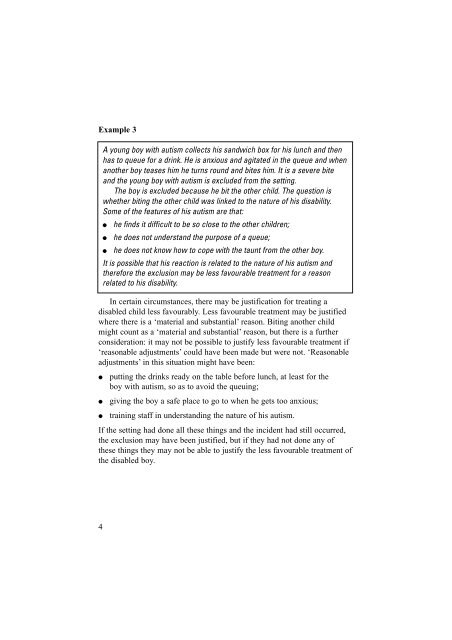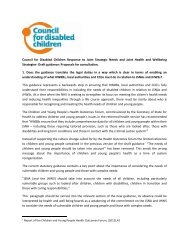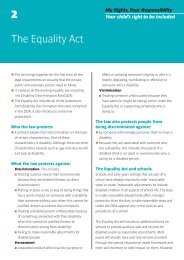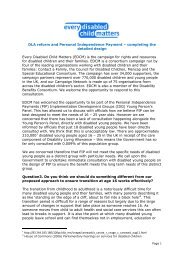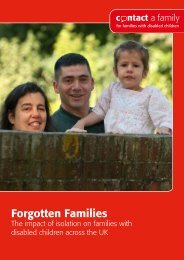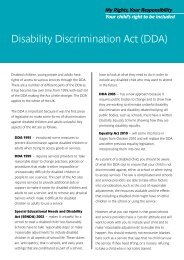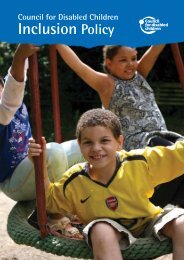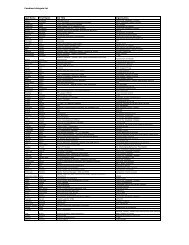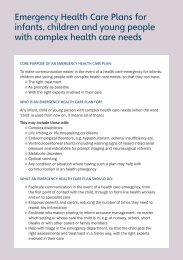Early years and the Disability Discrimination Act 1995 What service ...
Early years and the Disability Discrimination Act 1995 What service ...
Early years and the Disability Discrimination Act 1995 What service ...
You also want an ePaper? Increase the reach of your titles
YUMPU automatically turns print PDFs into web optimized ePapers that Google loves.
Example 3<br />
A young boy with autism collects his s<strong>and</strong>wich box for his lunch <strong>and</strong> <strong>the</strong>n<br />
has to queue for a drink. He is anxious <strong>and</strong> agitated in <strong>the</strong> queue <strong>and</strong> when<br />
ano<strong>the</strong>r boy teases him he turns round <strong>and</strong> bites him. It is a severe bite<br />
<strong>and</strong> <strong>the</strong> young boy with autism is excluded from <strong>the</strong> setting.<br />
The boy is excluded because he bit <strong>the</strong> o<strong>the</strong>r child. The question is<br />
whe<strong>the</strong>r biting <strong>the</strong> o<strong>the</strong>r child was linked to <strong>the</strong> nature of his disability.<br />
Some of <strong>the</strong> features of his autism are that:<br />
● he finds it difficult to be so close to <strong>the</strong> o<strong>the</strong>r children;<br />
● he does not underst<strong>and</strong> <strong>the</strong> purpose of a queue;<br />
● he does not know how to cope with <strong>the</strong> taunt from <strong>the</strong> o<strong>the</strong>r boy.<br />
It is possible that his reaction is related to <strong>the</strong> nature of his autism <strong>and</strong><br />
<strong>the</strong>refore <strong>the</strong> exclusion may be less favourable treatment for a reason<br />
related to his disability.<br />
In certain circumstances, <strong>the</strong>re may be justification for treating a<br />
disabled child less favourably. Less favourable treatment may be justified<br />
where <strong>the</strong>re is a ‘material <strong>and</strong> substantial’ reason. Biting ano<strong>the</strong>r child<br />
might count as a ‘material <strong>and</strong> substantial’ reason, but <strong>the</strong>re is a fur<strong>the</strong>r<br />
consideration: it may not be possible to justify less favourable treatment if<br />
‘reasonable adjustments’ could have been made but were not. ‘Reasonable<br />
adjustments’ in this situation might have been:<br />
●<br />
●<br />
putting <strong>the</strong> drinks ready on <strong>the</strong> table before lunch, at least for <strong>the</strong><br />
boy with autism, so as to avoid <strong>the</strong> queuing;<br />
giving <strong>the</strong> boy a safe place to go to when he gets too anxious;<br />
● training staff in underst<strong>and</strong>ing <strong>the</strong> nature of his autism.<br />
If <strong>the</strong> setting had done all <strong>the</strong>se things <strong>and</strong> <strong>the</strong> incident had still occurred,<br />
<strong>the</strong> exclusion may have been justified, but if <strong>the</strong>y had not done any of<br />
<strong>the</strong>se things <strong>the</strong>y may not be able to justify <strong>the</strong> less favourable treatment of<br />
<strong>the</strong> disabled boy.<br />
4


